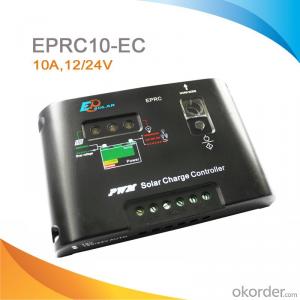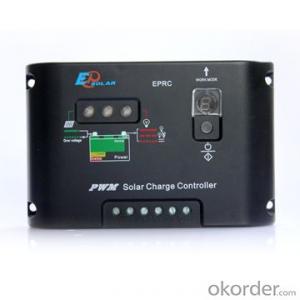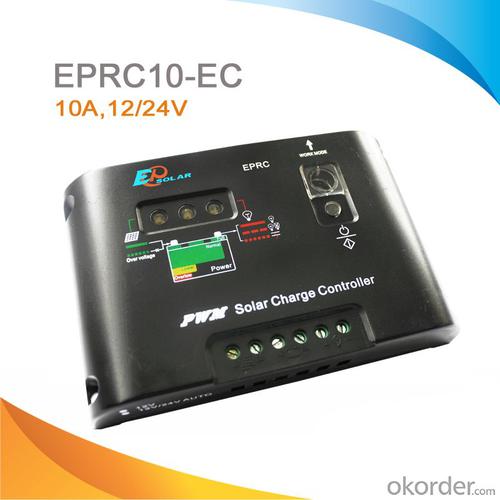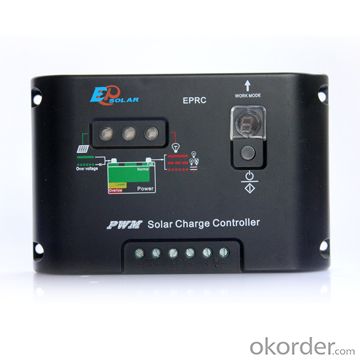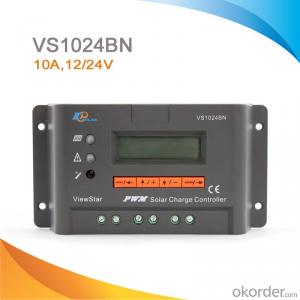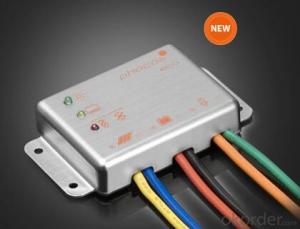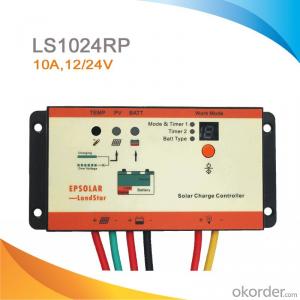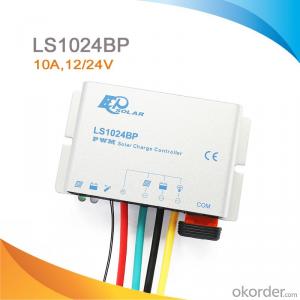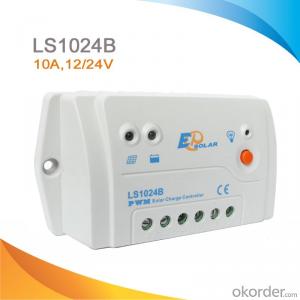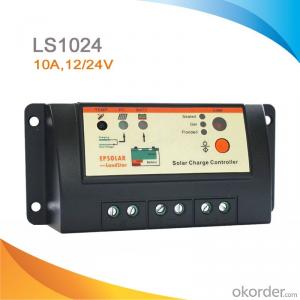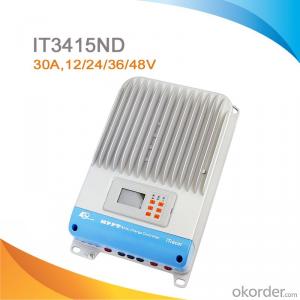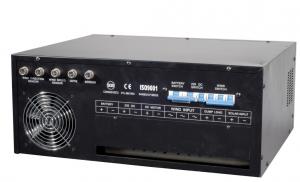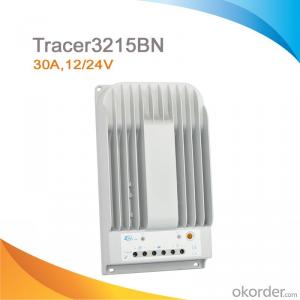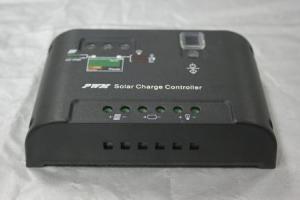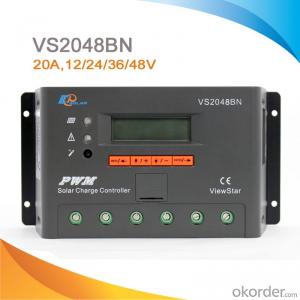Solar Street Light Controller,10A,12/24V,EPRC10-EC
- Loading Port:
- Tianjin
- Payment Terms:
- TT or LC
- Min Order Qty:
- -
- Supply Capability:
- 10000 pc/month
OKorder Service Pledge
OKorder Financial Service
You Might Also Like
EPRC10-EC series solar controller is a reliable and economical solar controller.
Dusk to Dawn, Light ON+ timer, TEST, ON/OFF
Features:
·Intelligent System Optimum Control
·12/24V auto work
·High efficient Series PWM charging with temperature compensation
·Use MOSFET as electronic switch, without any mechanical switch
·Load and battery status indicators
·Electronic protection: over charging, over discharging, overload, and short circuit
·Diversified load control modes : Manual, Light ON/OFF, Light ON+ Timer, Time Control
·Battery type selection: Gel, sealed, flooded and User type
·Real-time monitor
·Programmable parameters
·LVD or SOC load disconnect function
·Energy statistics function
Electronic Protections:
·PV short circuit
·PV reverse polarity
·Battery overcharge
·Battery over discharge
·Battery reverse polarity
·Load short circuit
·Load overload
·Overheating
Specification:
Electrical parameters | |
System voltage | 12 / 24VDC Auto work |
Nominal battery current | 10A |
Charge circuit voltage drop | ≤0.26V |
Discharge circuit voltage drop | ≤0.15V |
Self consumption | ≤6mA |
Equalize charging voltage | 14.6V;x2/24V |
Boost charging voltage | 14.4V;x2/24V |
Float charging voltage | 13.6V;x2/24V |
Low voltage reconnect charging voltage | 12.6V;x2/24V |
Under voltage warning voltage | 12V; x2/24V |
Low voltage disconnect voltage | 11.1V;x2/24V |
Equalize duration | 60 MINS |
Boost duration | 60 MINS |
Working temperature | -35℃ to +55℃ |
Humidity | 10%-90% NC |
Enclosure | IP30 |
Terminal | 2.5mm2 |
Net weight | 0.23kg |
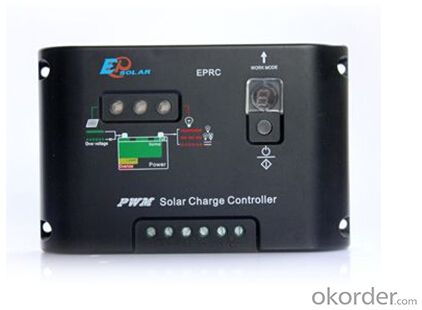
FAQ:
Q1. What is the voltage?
A1. Our 45/60A solar charge controller is 12/24/36/48V auto work.
Q2. What is the difference between MPPT&PWM?
A2. MPPT has higher efficiency, it can track the max power point and won't waste energy.
Q3. What is the efficiency of the MPPT controller?
A3. MPPT>99%, peak conversion efficiency>98%.
Q4. What is the waranty of product?
A4. 12 months.
Q5. What protection does your MPPT controller have?
A5. PV array short circuit, PV reverse polarity, Battery reverse polarity, Over charging, Output short circuit.
- Q: How does a solar controller handle battery equalization charging?
- A solar controller handles battery equalization charging by monitoring the voltage levels of each individual battery in a battery bank. When the controller detects that the voltage of one or more batteries is significantly lower than the others, it activates the equalization charging mode. During this mode, the solar controller applies a higher voltage to the battery bank, typically around 15 volts, to bring the lower voltage batteries up to the same level as the rest. This process helps to ensure that all batteries in the bank receive an equal charge, maximizing their performance and longevity.
- Q: Does a solar controller require any maintenance?
- Indeed, proper maintenance is necessary for a solar controller. While solar controllers are designed to be durable and dependable, regular maintenance is still required to ensure optimal performance and longevity. There are several common maintenance tasks that should be carried out: 1. Routine cleaning: Since solar controllers are typically installed outdoors, they are exposed to dust, dirt, and debris. Regularly cleaning the controller's surface, particularly the display panel, is essential to prevent any blockages or interference that may affect its functionality. 2. Inspection of connections: Over time, the connections between the solar controller, solar panels, batteries, and load may become loose. Regularly inspecting and tightening these connections guarantees uninterrupted power flow and mitigates potential issues. 3. Battery health monitoring: Solar controllers are responsible for charging and managing the battery bank. Monitoring the battery's state of charge, voltage, and overall health is crucial to prevent overcharging, deep discharging, or any other damage. If necessary, the battery may require maintenance, such as cleaning its terminals or equalizing the cells. 4. Updating firmware: Certain solar controllers have firmware that can be updated to enhance functionality, resolve bugs, or introduce new features. Checking for available updates and installing them as needed ensures that the controller is equipped with the latest software. 5. Physical damage inspection: Regularly inspecting the solar controller for any physical damage, such as a cracked casing or broken components, is important. If any damage is detected, it should be promptly repaired or replaced to avoid further complications. 6. System performance monitoring: Keeping track of the overall performance of the solar power system, including the solar controller, can help identify any irregularities or inefficiencies. This can be accomplished by monitoring energy production, battery charging/discharging patterns, and load usage. By consistently performing these maintenance tasks, the solar controller can function optimally and effectively manage the solar power system.
- Q: Can a solar controller be used with a solar microinverter system?
- Yes, a solar controller can be used with a solar microinverter system. The solar controller helps regulate and manage the flow of energy from the solar panels into the microinverters, ensuring optimal performance and efficiency of the system.
- Q: Can a solar controller be used with a solar-powered bus stop?
- Yes, a solar controller can be used with a solar-powered bus stop. A solar controller is responsible for regulating the power flow from solar panels to the connected devices or batteries. In the case of a solar-powered bus stop, a solar controller can efficiently manage the power generated by the solar panels, ensuring that the batteries are charged optimally and the bus stop's lighting, display boards, or any other devices are powered appropriately. This helps in maximizing the efficiency and reliability of the solar-powered bus stop system.
- Q: What is the compatibility of a solar controller with other components?
- The compatibility of a solar controller with other components refers to its ability to effectively work together with other devices in a solar power system. This includes compatibility with solar panels, batteries, inverters, and other equipment. It is essential for a solar controller to be compatible with these components to ensure optimal performance, efficient energy conversion, and reliable operation of the entire system.
- Q: How does a solar controller prevent damage from lightning-induced surges?
- A solar controller prevents damage from lightning-induced surges by incorporating surge protection devices such as varistors or transient voltage suppressors. These devices are designed to divert excessive voltage caused by lightning strikes away from sensitive electronic components, ensuring the safety and integrity of the solar system.
- Q: What is the maximum power loss in a solar controller?
- The maximum power loss in a solar controller typically depends on the design and efficiency of the controller. However, it is generally recommended to have a low power loss, ideally below 5% to ensure maximum energy conversion and minimize wastage.
- Q: Can a solar controller be used with solar panels of different wattage?
- Solar panels of different wattage can indeed be used with a solar controller. The primary role of a solar controller is to oversee the charging process of the solar panels, guaranteeing optimal battery charging while safeguarding against overcharging or harm. The wattage of the solar panels does not influence this. Nevertheless, it is crucial to take into account the voltage compatibility between the solar controller and the solar panels. To effectively regulate the charging process, the solar controller must be capable of managing the voltage range of the solar panels.
- Q: Can a solar controller be used with a solar-powered gate opener?
- Yes, a solar controller can be used with a solar-powered gate opener. A solar controller helps regulate the charging and discharging of the battery connected to the solar panel. It ensures that the battery is properly charged and protected from overcharging or discharging, which is essential for the efficient functioning of a solar-powered gate opener.
- Q: What is the maximum power consumption of a solar controller?
- The maximum power consumption of a solar controller can vary depending on its specific design and features. Generally, the power consumption of a solar controller is quite low, typically ranging from a few milliwatts to a few watts. This low power consumption allows the controller to efficiently regulate and manage the energy flow from the solar panels to the battery or load.
Send your message to us
Solar Street Light Controller,10A,12/24V,EPRC10-EC
- Loading Port:
- Tianjin
- Payment Terms:
- TT or LC
- Min Order Qty:
- -
- Supply Capability:
- 10000 pc/month
OKorder Service Pledge
OKorder Financial Service
Similar products
Hot products
Hot Searches
Related keywords
